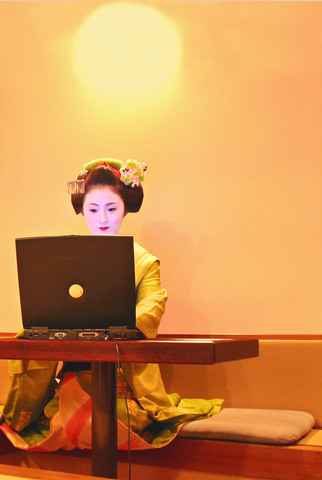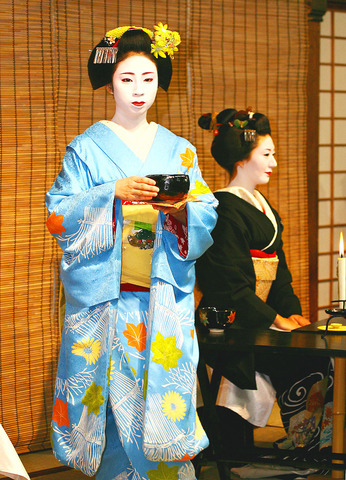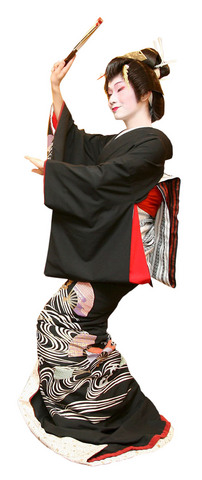Ichimame's life is already an endless blur of parties, visits to the hairdresser, kimono fittings, lessons in traditional dance, music and tea ceremony, and countless hours in front of the mirror painting her face chalk white and her lips impossibly red.
Even so the Japanese 18-year-old still manages to find the time to keep what is probably the first Internet blog by an apprentice geisha, opening a small window onto a world shrouded in mystery and often misunderstood.
The elite entertainers of Japan's pleasure quarters have for centuries been fawning over wealthy guests in the cosy confines of teahouses and restaurants.

PHOTO: AFP
Now, facing growing competition from nightclubs, karaoke and hostess bars, Kyoto's geisha are gradually joining the 21st century with Web sites, English lessons and gradually less rigid introduction rules.
Some do modeling or even go on overseas tours.
Wedged in a row of wooden buildings on a narrow street in Kamishichiken, the oldest of Kyoto's five geisha districts, or hanamachi (flower towns), the Ichi teahouse certainly doesn't look like the typical home of an Internet blogger.

PHOTO: AFP
But it is here that for the past year Ichimame has been writing about her daily endeavors to master the three-stringed shamisen and the shakuhachi bamboo flute, and complicated traditional dance steps.
The site (ichi.dreamblog.jp), which is written in the lilting Kyoto dialect, has been getting thousands of hits every month from readers eager for a glimpse into the famously secretive world of the geisha.
Kneeling on the woven straw tatami matting of the teahouse, resplendent in a flowing green kimono, her hair perfectly coiffured and a face like a porcelain doll, Ichimame explained that through her blog she hoped to encourage other girls who might be thinking of becoming maiko, or young geisha.

PHOTO: EPA
Like her, many girls apply to become a maiko after they turn 15 but when they learn of the strict regime they often change their minds, says Ichimame, who declines to divulge more than her professional maiko name.
In the 1920s there were tens of thousands of geisha in Japan, but these days in Kyoto there are estimated to be about 280 geiko and maiko.
"So even if there are girls who want to become a maiko, the number of girls actually becoming one is quite small. I hope my blog will be a helping hand to those girls who really want to become a maiko," she said.
Her blog has already encouraged one girl to become a maiko at the Ichi teahouse, which now has three maiko and one geisha, or geiko as they prefer to be called in Kyoto.
In one recent entry, Ichimame described on her blog how she applies her make-up, including the white oshiroi face powder.
"Under my eyes, I add a hint of red. I paint my cheeks with pink and finally I paint my lips with rouge dissolved in water," she wrote.
Selling dreams
Like others in the geisha world, Susumu Harema, the 35-year-old manager of the Ichi teahouse, feels that foreign novels and films often misrepresent the artist-entertainers. Many foreigners have long assumed geisha are prostitutes because they are paid by predominantly male customers for their company.
The reality, he says, is "very different from the old-fashioned image that foreigners have" of a woman who sells herself to customers.
"That kind of thing does not happen, not once among our maiko and geisha here in Kyoto. While entertaining guests, the Maiko sings, dances and chats. That's her job."
Even today some people think Maiko are sold into the profession in payment for debts. In fact the choice is their own and they must persuade the head of the teahouse to accept them.
During their early days in the teahouse, the Maiko help with chores while learning customs. Usually it takes about half a year to become a Maiko, after which they accompany geisha on their appointments.
In a hosting room of a teahouse, Maiko and geiko sit next to their customers, pouring them drinks, dancing and playing music, all to help their wealthy clientele relax and forget the daily grind of Japanese life.
"They sell dreams. And your dream is not to be having a conversation with your wife," said long-time Kyoto resident Peter MacIntosh, who has spent a decade photo-graphing, studying and hiring geisha. He even married one.
"When you're with a geisha you don't talk about your rent or your water bills. They make you feel special. 'You' being man, woman or child," added MacIntosh.
For Ichimame the best part of her life as a Maiko is being invited to some of Kyoto's top restaurants, places that most girls her age can only dream of, or, more mundanely, to be told by her teachers that her singing has improved.
Among the hardest things, she says, is having to ensure her elaborate hairstyle remains perfect by sleeping on a high pillow to support her neck.
"In the beginning I was unable to fall asleep. I was worried thinking, 'What will I do if my hair falls out of place?' I'd keep waking up and falling asleep thinking about that," she said.
Unlike about half the young geiko who are attracted to this mysterious and glamorous world from outside Kyoto, Ichimame is a native of the ancient capital.
Maiko must wait until they turn 20 before they can become geiko, after which they gradually wear less colorful kimono and make-up.
Ichimame says she was 11 years old when, while watching geisha perform at an annual spring temple festival, she decided that she too wanted to wear the sculptured hair and beautiful kimono, and learn traditional dancing.
Her parents were supportive, although nowadays she is only allowed to visit them twice a year, at new year and the Obon family holiday in August.
Her daily life is now in the hands of the teahouse mistress, who is addressed as okaasan (mother) and controls every detail of Ichimame's life, right down to which kimono she wears when she goes out to entertain customers.
Indeed, it is only with the permission of the teahouse, which encouraged her to start her blog on its Web site, that Ichimame is able to keep her online diary — in which she is careful not to divulge any secrets about customers.
A world wary of outsiders
The closest most people will ever get to meeting Ichimame, or any other geisha, is by visiting her Web site.
Unless introduced by a regular customer, outsiders cannot even step into a decent teahouse, the place that organizes a night with a geiko. With the right introduction, however, even non-Japanese guests are admitted.
"If a foreigner comes on introduction, of course he is welcome," explained Harema, the teahouse manager.
"When you go to a restaurant you ask whether you can be introduced to a Maiko. And that restaurant — if it knows any teahouses — can ask permission to introduce a guest to the Maiko.
"But if someone comes knocking here asking, 'Excuse me, I would like to see a Maiko,' he will automatically be refused," said Harema.
He said that through Ichimame's blog, the teahouse hopes to keep the traditions of the geiko alive and help make the Kamishichiken district, tucked behind the Kitano Tenmangu shrine in northern Kyoto, better known.
"It's important to protect this culture especially in this age, but at the same time I also don't think it's good or possible for outsiders to enter. So it's hard to find a balance between the two," he said.
A job for life, unless you marry
Being a geiko is a job for life — until they marry. Then they must retire.
Ichimame giggles when asked if she expects to wed. "Oh, I haven't given it a thought yet," she said.
"To marry means to stop being a geiko," explained Harema. "To be married and to be a geiko is impossible."
Before World War II, many geiko had male sponsors and some of the artisans chose to become their sponsors' lovers outside wedlock. Still today it is not unknown for geiko to fall in love with their customers.
"Of course when wealthy businessmen, successful men, and beautiful, artistically trained women hang out a lot they fall in love," said MacIntosh.
But he stresses that geisha are not prostitutes. "There's a difference between sex and sex appeal," he says.
Fueled by the success of books like Arthur Golden's Memoirs of a Geisha and the movie it inspired, Kyoto has a thriving geisha tourism industry offering tours, an evening with a geiko and a chance to dress up in the fabulous costumes of the Maiko.
Few of the "maiko" who can be seen at Kyoto's famous scenic spots surrounded by tourists are the real thing, although sometimes genuine geisha can been spotted in hanamachi districts like Gion as they step out gracefully in wooden platform sandals on their way to evening appointments.
Ichimame said she had nothing against tourists dressing up as Maiko, but admitted she worried that people might think they are the genuine article.
"People will think Maiko always wear that kind of kimono. We never walk into convenience stores with this kind of hairstyle. But they do. So if we think about our image, we wouldn't really want them to be walking outside, although we understand their desire to be looked at," she said.
On her days off she dreams of visiting far-flung countries. Sometimes geiko are invited to go overseas to perform and Ichimame hopes one day she will have the opportunity.
"I would like to go to France, Italy, Hawaii. I have never boarded a plane, so that is the first thing I want to do," she said.
"I dream a lot."

That US assistance was a model for Taiwan’s spectacular development success was early recognized by policymakers and analysts. In a report to the US Congress for the fiscal year 1962, former President John F. Kennedy noted Taiwan’s “rapid economic growth,” was “producing a substantial net gain in living.” Kennedy had a stake in Taiwan’s achievements and the US’ official development assistance (ODA) in general: In September 1961, his entreaty to make the 1960s a “decade of development,” and an accompanying proposal for dedicated legislation to this end, had been formalized by congressional passage of the Foreign Assistance Act. Two

Despite the intense sunshine, we were hardly breaking a sweat as we cruised along the flat, dedicated bike lane, well protected from the heat by a canopy of trees. The electric assist on the bikes likely made a difference, too. Far removed from the bustle and noise of the Taichung traffic, we admired the serene rural scenery, making our way over rivers, alongside rice paddies and through pear orchards. Our route for the day covered two bike paths that connect in Fengyuan District (豐原) and are best done together. The Hou-Feng Bike Path (后豐鐵馬道) runs southward from Houli District (后里) while the

March 31 to April 6 On May 13, 1950, National Taiwan University Hospital otolaryngologist Su You-peng (蘇友鵬) was summoned to the director’s office. He thought someone had complained about him practicing the violin at night, but when he entered the room, he knew something was terribly wrong. He saw several burly men who appeared to be government secret agents, and three other resident doctors: internist Hsu Chiang (許強), dermatologist Hu Pao-chen (胡寶珍) and ophthalmologist Hu Hsin-lin (胡鑫麟). They were handcuffed, herded onto two jeeps and taken to the Secrecy Bureau (保密局) for questioning. Su was still in his doctor’s robes at

Mirror mirror on the wall, what’s the fairest Disney live-action remake of them all? Wait, mirror. Hold on a second. Maybe choosing from the likes of Alice in Wonderland (2010), Mulan (2020) and The Lion King (2019) isn’t such a good idea. Mirror, on second thought, what’s on Netflix? Even the most devoted fans would have to acknowledge that these have not been the most illustrious illustrations of Disney magic. At their best (Pete’s Dragon? Cinderella?) they breathe life into old classics that could use a little updating. At their worst, well, blue Will Smith. Given the rapacious rate of remakes in modern